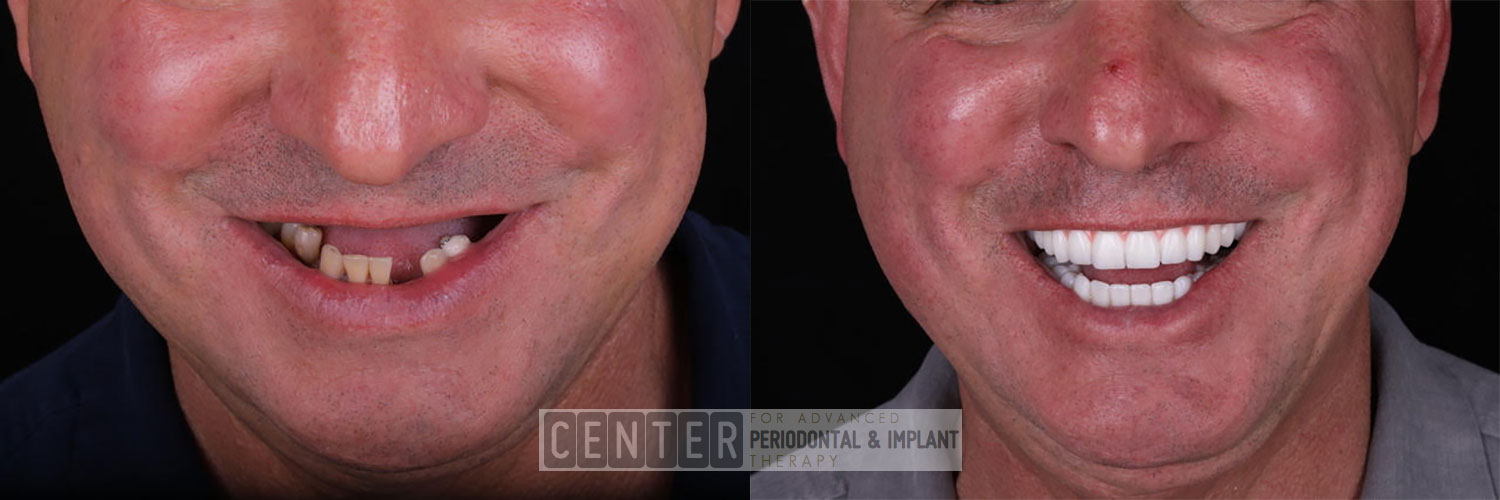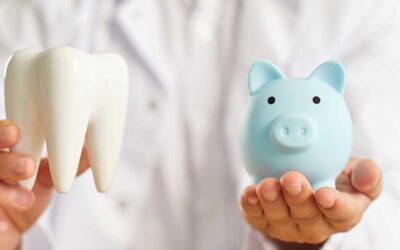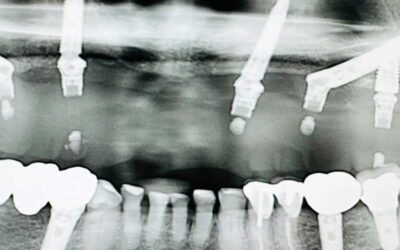Are Dental Implants Noticeable?
If you’ve lost one or more teeth due to periodontal disease, trauma, or other dental issues, you might be considering ways to restore your smile. Missing teeth can lead to both cosmetic and health problems, such as shifting teeth, difficulty chewing, and potential infections. Fortunately, dental implants provide an effective, natural-looking solution for many patients.
One of our patients’ most common concerns is whether dental implants are noticeable. The simple answer is that when done correctly, dental implants should not be noticeable to others. Designed to mimic the look and function of your natural teeth, dental implants are custom-crafted to blend seamlessly into your smile. Here, we’ll answer some common questions surrounding their appearance.
Can Someone Tell I Have a Dental Implant?
No—dental implants are often designed to be indistinguishable from your natural teeth. Each implant is custom-made to match the shape, size, and color of your existing teeth. Skilled periodontists like Dr. Aalam and Dr. Krivitsky at the CENTER for Advanced Periodontal & Implant Therapy ensure that the implant integrates perfectly with the rest of your smile.
Dental implants consist of a titanium or zirconia post that is surgically inserted into your jawbone and a porcelain crown that sits on top. Once your gum heals and the implant is securely fused to the bone, the visible crown will appear as a natural tooth. Because the implant post is hidden under the gumline, no one can tell you have a dental implant.
Is It Normal to See My Dental Implant?
You should not be able to see the actual dental implant, which consists of a titanium post surgically inserted into your jawbone. The only visible part of your implant should be the porcelain crown, carefully crafted to blend in seamlessly with your natural teeth and gumline. The crown is designed to mimic the size, shape, and color of your existing teeth, providing a discreet and natural-looking result.
However, if you notice any part of the implant itself—such as the metallic titanium post or a small edge near the gumline—this could be a sign of gum recession or improper healing. It’s important to contact your periodontist right away in these cases, as exposed implant components may not only affect the aesthetics of your smile but could also lead to further complications.
In most cases, you shouldn’t be able to see the implant post itself, as it remains securely beneath the gumline. However, if you notice a metallic edge near your gumline, it’s likely due to one of the following causes.
What Causes Implant Post Exposure?
There are a few reasons why the implant post may become visible, most commonly due to gum recession. Gum recession can happen for several reasons, including:
- Inadequate gum tissue: Some patients may naturally have thinner gum tissue or experience receding gums, which could lead to insufficient coverage of the implant post.
- Improper healing: In some cases, the gums may not heal properly after surgery, leading to gaps between the gum line and the implant crown.
- Gum disease: Periodontal disease or infections around the implant site can cause the gum tissue to recede, exposing the titanium post.
- Bone loss: Lack of sufficient bone density in the jaw may result in an implant not fully covered by gum tissue.
Thankfully, if your implant post is exposed, advanced treatments are available to restore the gumline and protect your implant. Here’s how our periodontists address gumline exposure to ensure your smile stays healthy and natural-looking.

How Our Periodontists Address Gumline Exposure
At the CENTER for Advanced Periodontal & Implant Therapy, our periodontists specialize in addressing gumline issues before, during, or after dental implant surgery. Several techniques can help ensure that the implant post is properly covered by healthy gum tissue, enhancing both the appearance and longevity of your dental implants.
Gum grafting is one of the most effective techniques to cover an exposed implant post and restore a natural gumline. Let’s look at how this procedure works and how it can help.
Gum Grafting
Gum grafting is a highly effective method for restoring lost gum tissue and covering any exposed implant components. During this procedure, your periodontist takes tissue from another area of your mouth (or uses donor tissue) and grafts it onto the affected area. This helps rebuild the gumline around the implant, ensuring the post is fully covered, and your smile looks natural again.
Gum grafting is often performed either prior to implant surgery, for patients with thin gum tissue, or after the procedure if gum recession occurs during healing.
We also offer an innovative RejuvaGum Lift™ treatment, an alternative approach to traditional gum grafting for restoring gum tissue and protecting dental implants.
RejuvaGum Lift™: Restoring Your Gumline Naturally
If you have gum recession or it has already exposed your implant post, Dr. Aalam and Dr. Krivitsky offer an innovative solution called the RejuvaGum Lift™. This signature treatment rejuvenates and rebuilds the gumline. This procedure combines gum grafting with PRF therapy to naturally regenerate the gum tissue and provide long-term coverage for your implant.
One of our patients came to us worried about a receding gumline that had exposed part of her implant. Using the RejuvaGum Lift™, we were able to restore her gumline, leaving her with a beautiful, natural smile she feels confident about.
Dr. Aalam is a pioneer in Advanced PRF and the RejuvaGum Lift™ technique, making him one of the foremost experts in treating gum recession around dental implants. By using this cutting-edge method, your gumline can be restored to its natural position, ensuring that your dental implants remain discreet and aesthetically pleasing.
An essential component of the RejuvaGum Lift™ is the use of Platelet-Rich Fibrin (PRF) therapy, which enhances the healing process. This advanced technique works alongside gum grafting and the RejuvaGum Lift™ to ensure faster recovery and better implant integration.
Platelet-Rich Fibrin (PRF) Therapy for Faster Healing
For optimal healing, we also offer Platelet-Rich Fibrin (PRF) therapy. PRF is an advanced technique that uses a small sample of your blood to create a fibrin membrane rich in healing proteins and growth factors. This fibrin layer is applied directly to the surgical site to stimulate faster healing and reduce the risk of complications, such as gum recession.
PRF encourages your gum tissue to regenerate more quickly, ensuring that healthy gums fully integrate and protect the implant. It also minimizes discomfort and reduces the chance of infection, giving you the best possible outcome.
Whether you undergo gum grafting or a RejuvaGum Lift™, maintaining healthy gums is key to ensuring the success and longevity of your dental implants. Here’s how you can keep your implants secure and discreet.
Ensuring Your Dental Implant Remains Secure and Discreet
The key to a successful dental implant is proper placement and maintenance of the surrounding gum tissue. In healthy situations, the porcelain crown should fit snugly along your gumline, indistinguishable from your natural teeth. Maintaining good oral hygiene, such as brushing, flossing, and regular dental checkups, plays a crucial role in keeping your gums healthy and your implants secure.
If you suspect that your implant post is becoming visible, or you are concerned about your gumline, don’t hesitate to reach out to our team. With advanced treatments like gum grafting, PRF therapy, and the RejuvaGum Lift™, we can effectively address any issues and help restore your smile to its natural beauty.
Call Us Today to Learn More About Dental Implants
If you’re considering dental implants, our expert periodontists, Dr. Aalam and Dr. Krivitsky, are here to help. With years of experience in implant dentistry, they can evaluate your needs and recommend the best treatment options for you. Don’t let missing teeth affect your confidence and oral health any longer. Contact the CENTER for Advanced Periodontal & Implant Therapy at (310) 826-8242 to schedule your consultation and learn more about how dental implants can transform your smile.
You May Also Like...
How Much Do Dental Implants Cost in Southern California? A Complete Guide
If you're considering dental implants in Southern California, you’re likely wondering: How much will they cost? Are...
Can Zygomatic and Pterygoid Implants Be Done in a Day? Breaking Down the Process
Losing bone in the upper jaw can feel overwhelming, especially if you've been told traditional implants aren’t an...
Implants More Successful with a Seasoned Periodontist
Dental implants can provide a great alternative to traditional bridges or dentures for tooth restoration. However, not...



